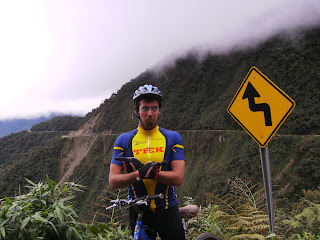 My track record on bicycles is not stellar. Ever since my first attempt at flying, immediately following a certain front-brake locking incident, resulting in a slightly shortened right clavicle, I've had a bit of a phobia of the things. Which is why, as I sped downhill along the Yungas road to Coroico and the rest of the peloton of Aussies, Kiwis, English, Germans, and other tourists zipped by me, I was perfectly content to keep my hands on the brakes.
My track record on bicycles is not stellar. Ever since my first attempt at flying, immediately following a certain front-brake locking incident, resulting in a slightly shortened right clavicle, I've had a bit of a phobia of the things. Which is why, as I sped downhill along the Yungas road to Coroico and the rest of the peloton of Aussies, Kiwis, English, Germans, and other tourists zipped by me, I was perfectly content to keep my hands on the brakes.I'm hardly above making testosterone-fueled asinine decisions. That wisdom is still a few years off. But I know when I'm a fish out of water. And I think that's a good thing, particularly when a lack of guardrails on a single lane dirt road with 300 m vertical dropoffs are involved.

The Yungas road is considered to be the most dangerous road in the world. Constructed with a lot of TNT and some Paraguayan POW's in the 1930's, it's finally seen enough cars slip off its formidable edge to have convinced the Bolivian government to build an alternate, safer route. However, mountain biking the Yungas road to Coroico has become one of the most popular tourist attractions around the La Paz area. It's significantly safer on a bicycle than it used to be when it was the major route for all vehicles...but the abundant crosses and memorials that dot the edge of the cliff, the recent ones mostly results of mis-steps from cyclists, would humble the most valiant of riders.
I crawled along, hugging the opposite side from the abyss. Peeking over the edge, one can only ponder life and death...and remember Spanish pearls of wisdom:

El cemetario está lleno de valientes, y los pacificos echan cuentos.
The cemetary is full of heroes, and pacifists live on to tell the stories.
As the years go on, as the Democratic Republic of My Forehead persists in annexing the Wilderness of My Hair, I imagine my stories will slide in the direction of less credible, and this fish should get bigger along with the rest of them. Did I say 10 mph? I think it was more like 20...



 Anlli llanchu, cochi wato. That's how you say, "What's up, player/ladies' man/mujeriego" in Quechuan, the endemic language of Peru and principal tongue of the Incas. Why do I know this? Well, in my quest to become a polyglot, I figured French, Italian, Portuguese and Romanian were far too logical follow-up idioms to Spanish...and decided to pester the Inca Trail guide and porters for useless Quechuan phrases. Our cook happened to be bragging about the 3 ex girlfriends he had recently separated with (a result of the young ladies having met one another), and our female guide was teasing him for being a cochi wato. So good, I have a basic greeting and an insult/compliment down. That should only leave about a billion Quechuan words to go.
Anlli llanchu, cochi wato. That's how you say, "What's up, player/ladies' man/mujeriego" in Quechuan, the endemic language of Peru and principal tongue of the Incas. Why do I know this? Well, in my quest to become a polyglot, I figured French, Italian, Portuguese and Romanian were far too logical follow-up idioms to Spanish...and decided to pester the Inca Trail guide and porters for useless Quechuan phrases. Our cook happened to be bragging about the 3 ex girlfriends he had recently separated with (a result of the young ladies having met one another), and our female guide was teasing him for being a cochi wato. So good, I have a basic greeting and an insult/compliment down. That should only leave about a billion Quechuan words to go.














